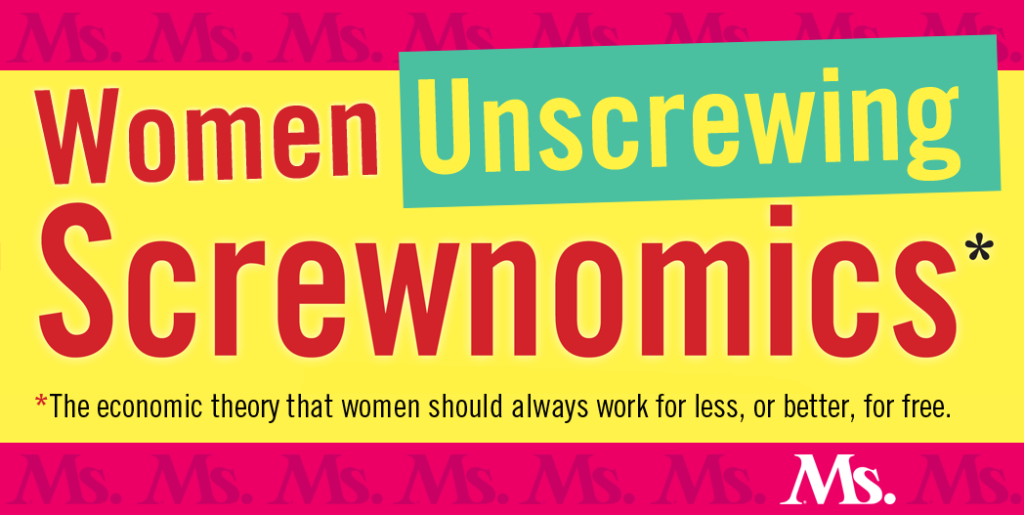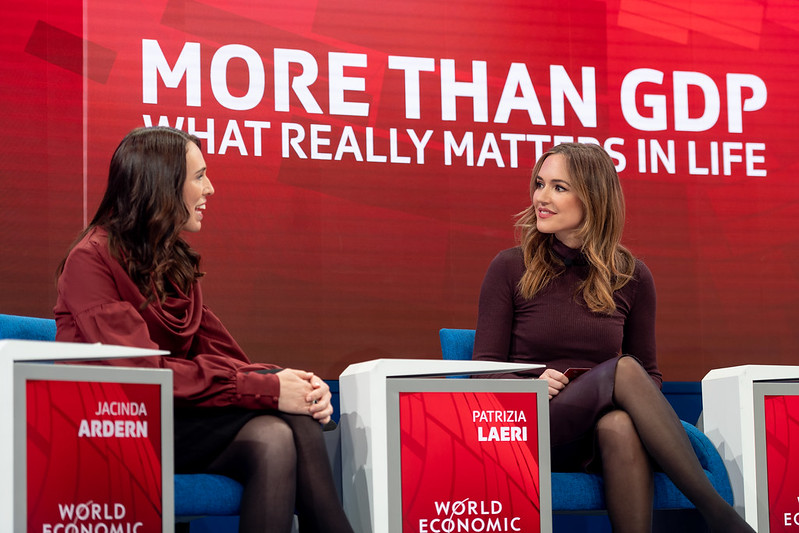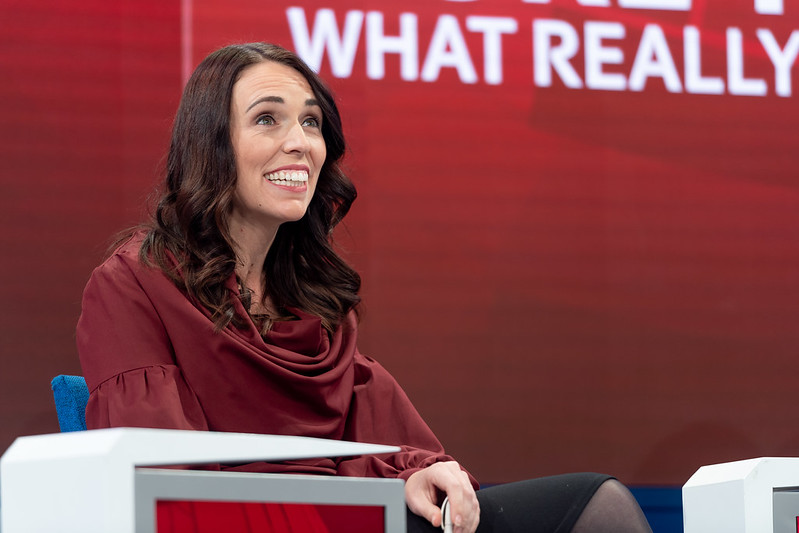
It’s time to talk about women’s economics with attitude. It’s time to laugh at what is often absurd and call out what is dangerous. By focusing on voices not typically part of mainstream man-to-man economic discourse, Women Unscrewing Screwnomics will bring you news of hopeful and practical changes and celebrate an economy waged as life—not as war.

Pictured: Jacinda Ardern, Prime Minister of New Zealand; Patrizia Laeri, anchor at Swiss Television SRF, speaking during a “More than GDP” session at the Annual Meeting 2019 of the World Economic Forum in Davos, January 23, 2019. (World Economic Forum / Sandra Blaser)
Americans tend to believe the economy must grow—but why exactly? What drives this growth imperative? People and families and trees grow pretty naturally, but when we speak of economic growth, we’re talking about pressures to make more money. For most of us, there never seems to be enough.
In fact, the measurement of economic growth, called the GDP (Gross Domestic Product), has one criteria: It adds up dollars. My earlier column on Riane Eisler and the GDP tells the history of this money-measure’s wrong-headed guidance and women’s wider perspective.
But the real question right now, while the economy collapses around us, asks why a growth-pressured economy falls apart so quickly? Until the pandemic, we were told this economy was booming.
Really?
Before the pandemic, four out of ten families couldn’t cover a $400 emergency. Now we learn that half our small businesses haven’t enough cash on hand for more than a month—and they employ nearly half of our workforce. Sixty percent of layoffs from this crash are women. No surprise then that more females on Mainstreet—and elected women leaders in Finland, Iceland and New Zealand—are saying: Hey, this growth economy is exhausting us.
Nomi Prins, the former Wall Street executive who wrote about the 2008 crash in It Takes A Pillage, said in a recent piece from Tom’s Dispatch:
“None of this is that complicated: When a system is steeped in so much debt that companies can’t make even low-rate debt payments and have insufficient savings for emergencies, they can crash—fast.”
Wall Street maneuvering, record-breaking corporate stock buybacks, and the Fed’s ultra-low interest rates helped grow another “epic debt bubble,” Prins explains. A year after the 2008 crash, the average American company owed $2 of debt for every dollar it earned. “Today it’s as high as $15 to $1.”
I recently spoke with Crystal Arnold, an economist who, over the past four years has interviewed more than a hundred Money-Wise Women at her podcast. She talks with impact investors, psychologists, social workers, public banking advocates, financial planners and organizers of cooperative businesses and credit unions.
Most interestingly, for the past three years, she has served as education director at The Post-Growth Institute. How can an economist want something called post-growth?

She told Ms.: “We are seeing a huge wealth transfer in the CARES Act, giving benefit to private corporations, and the taxpayers will pay for it.”
She noted its emphasis on providing money through corporations and small businesses, backing corporate loans through banks, rather than providing direct help to individuals. The result is a very complicated bill, which makes oversight more difficult.
She added, “Transparency is a big part of creating a more just economy. People often don’t have the information they need to make decisions in line with their values. Complex details of tax law, investment instruments and bailouts make manipulation by those gaming the system easier.”
Arnold points out that while the U.S. economy supposedly boomed, people’s debt from medical bills, student loans and credit card debt piled up, too. Growing debt is a worldwide phenomenon. During the first three quarters of 2019, global debt grew to $253 trillion, a record high—more than three times the global GDP. Unlike debt’s exponential growth, the planet and its people have physical limits.
“Our money is created as debt,” Arnold emphasizes, the problem at its root.
She began to question a money system getting bigger, not better in 2004, while working in a wealthy Wyoming town at The Bank of Jackson Hole. The CEO of the bank had just been indicted for embezzling $1.5 million over a decade. Her first job, copying evidence of his theft, made her begin to question: When is enough, enough?
She says, “When I worked at the bank, I saw how loans were made. The women in the loan department would enter a few keystrokes, and debt would be in someone’s name, and money would appear in their account. But banks never created the extra little bit we call interest.”
As a result, Arnold explains, “There’s never enough money in circulation to repay debts plus interest.”
During economic downturns, we can more clearly see a system that extracts value from those who borrow to survive, while growing the wealth of the already wealthy. More and more of the world’s money gets controlled by a small number of people. Forbes most recent report on billionaires shows record numbers of these, and some downturns in 2020; they actually call a few billionaires “poorer.”
Imagine the plight of being down to your last billion. But what happens in a pandemic when too many debts cannot be repaid?
“It’s a very insecure, brittle and fragile system,” says Arnold. “Many countries are on the brink of not being able to repay national debts. GDP gives us a false sense of security. An outdated economy equates success with growth and production. But a post-growth economy looks to other measures, like the recent move to account for well-being by Prime Minister Jacinda Ardern.”
New Zealand’s head of government, Jacinda Ardern, is famous for saying it takes strength to be an empathetic leader. In May 2019, her national budget prioritized specific well-being goals to increase New Zealander’s happiness and trust in their government. The budget’s outcome won’t merely add up the Kiwi’s, New Zealander dollars. Sixty-one indicators will also report on the health of the people and their island ecosystem.

“Post-growth isn’t about ‘doing without,’” says Crystal Arnold, but about changing expectations that demand constant growth, while ignoring the damage it does to the environment and our social fabric. “Post-growth isn’t about economic shrinking, but about redefining wealth, success and ownership.”
Ardern hasn’t claimed to be post-growth, but her government’s aim of well-being provided a simpler, faster response to the pandemic than U.S. officials worried by GDP. In early March, with only eight reported cases of COVID-19 in a population of 4.8 million people, New Zealand anticipated the impact on an economy dominated by tourism. They quickly created a twelve billion Kiwi (NZ$) stimulus package (about $7.3 billion in US$), equal to about four percent of their nation’s GDP. Ninety percent of those Kiwi’s went directly to people for income support, wage subsidies, and tax relief for small businesses. Only a fraction went to their airline industry.
By comparison, in late March, the US reported 136,880 cases of COVID-19 in a population of 327 million. Our $2 trillion CARES (Coronavirus Aid, Relief & Economic Security) stimulus equaled 9.8 percent of GDP, yet only thirty percent, or about $604 billion, was slotted for direct payments and expanded unemployment benefits. Some mortgage and student loan payments were suspended, but not forgiven.
Fully a quarter of CARES money went to big corporate loans, mostly for airlines to the tune of about $58 billion. A set aside for “national security” is widely believed to be for Boeing—remember them?
The Small Business Administration (SBA) got $350 billion, nearly 20 percent, but almost entirely for loans, and to businesses not as small as most women-owned micro-businesses.
Another quarter of the CARES Act increases health and education funding through state block grants, municipal funding and increases for SNAP and WIC food programs. All bring with them a world of bureaucratic complications for the majority women in this crisis.
Post-growth ideas with strong empathy seem especially timely right now. Check out Crystal Arnold’s podcasts at Money-Wise Women, and her blog at Money-Morphosis. Read Kate Raworth’s book, Doughnut Economics. Or try out a TedTalk by Tim Jackson, rightly called An Economic Reality Check.





